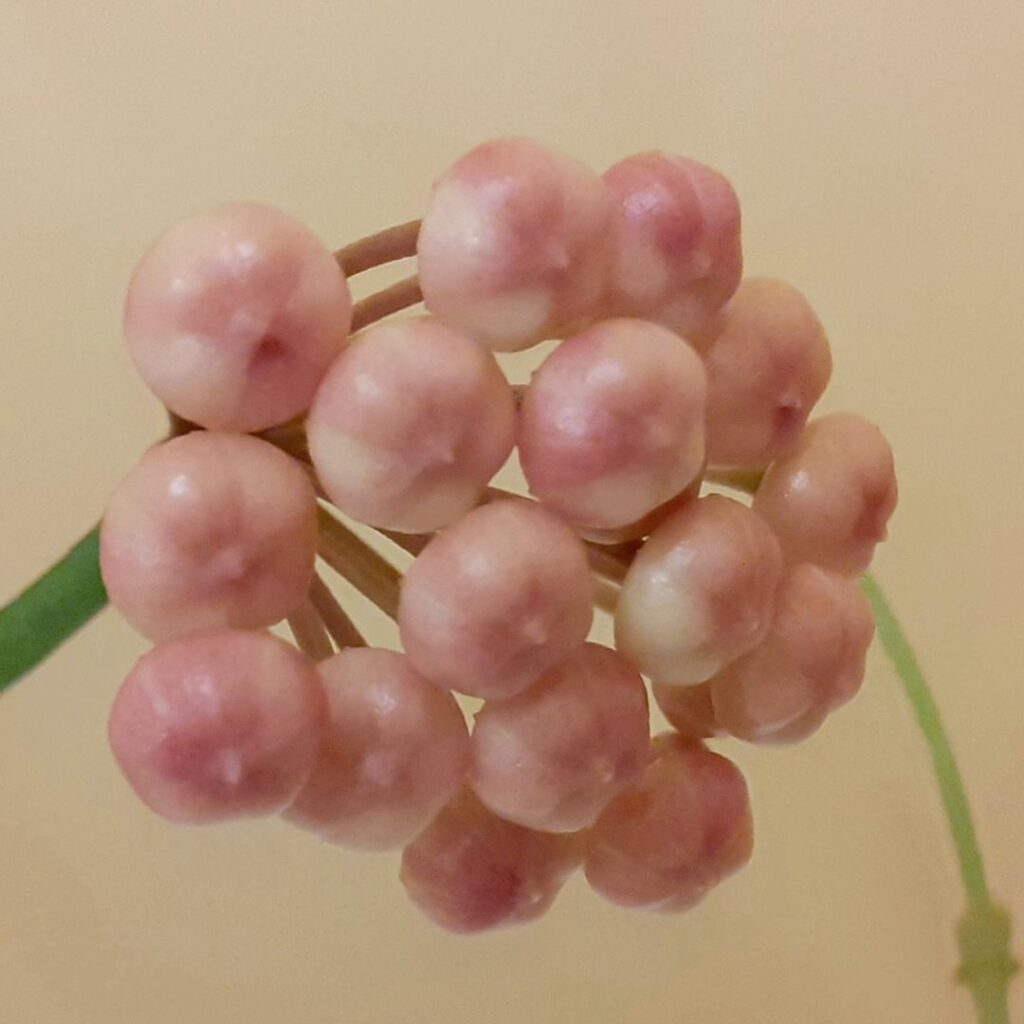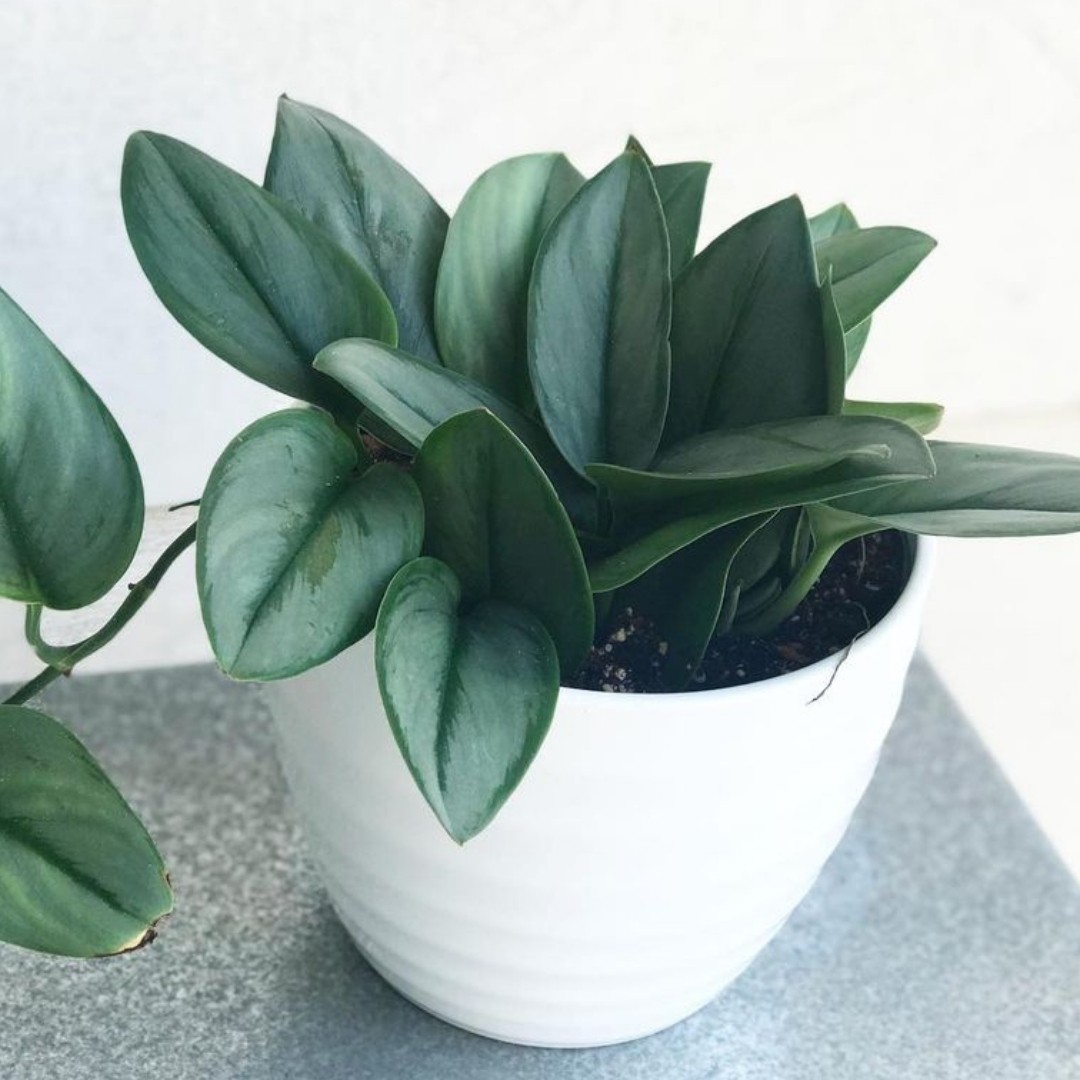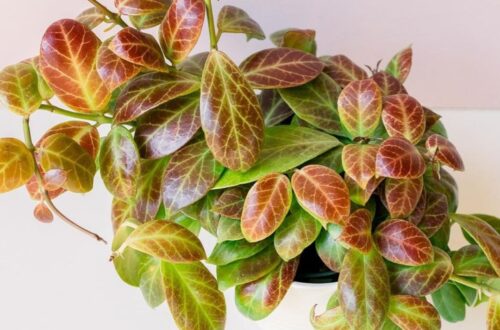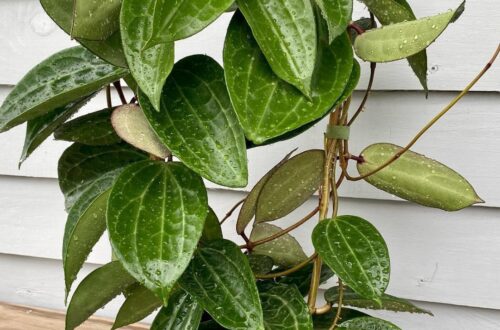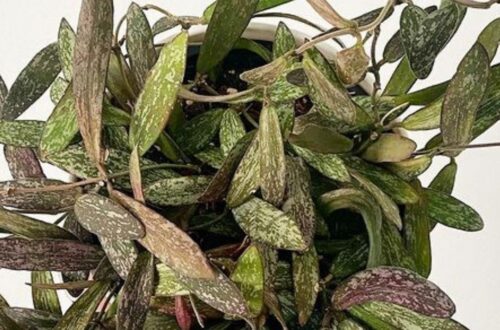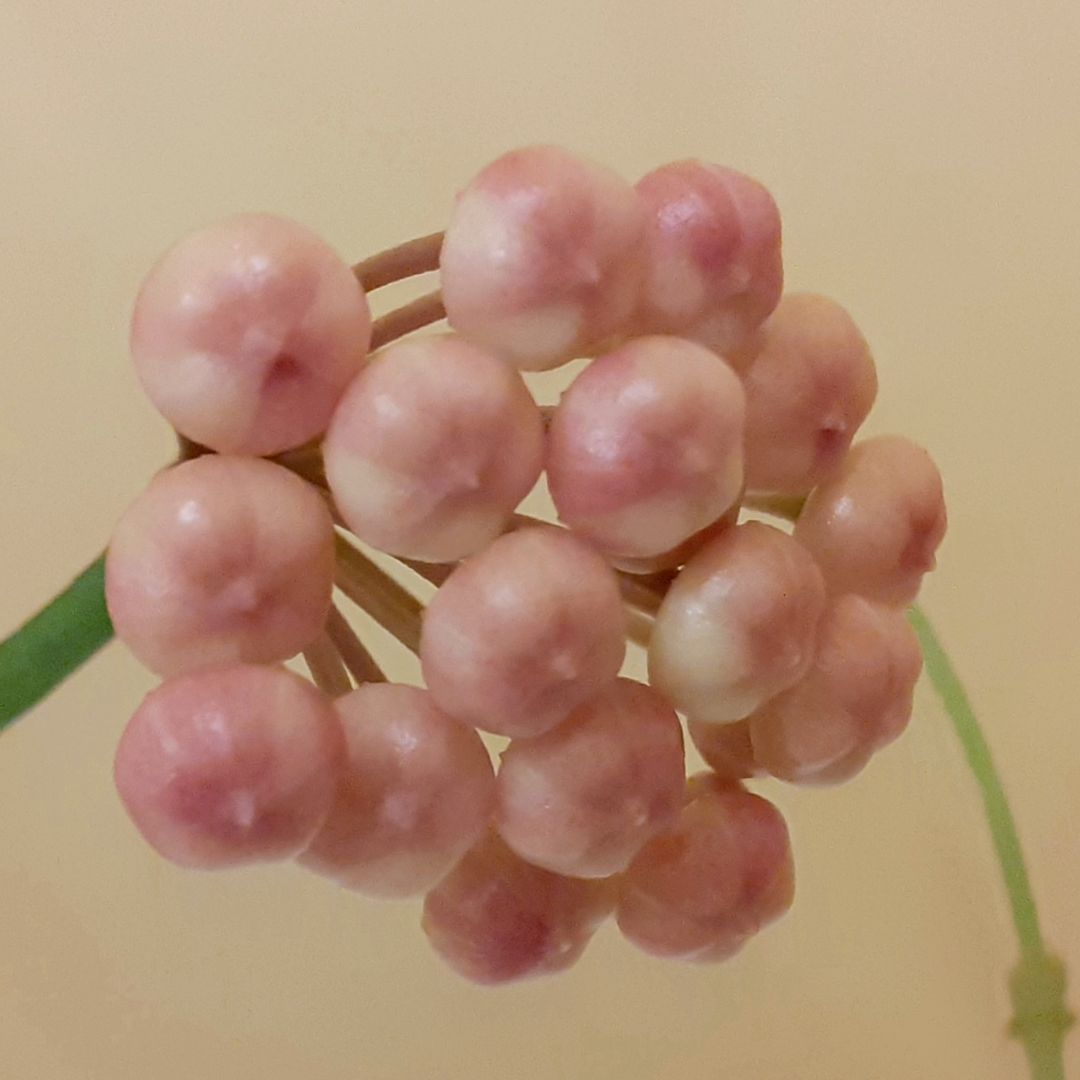
Hoya Rotundiflora
A very unique Hoya, the Rotundiflora is a forgiving, easy to care for, eye-catching specimen, we cover all you need to know about care and propagation..
Hoya Rotundiflora Care Summary
| Light needs: | Bright indirect sunlight. |
| Watering needs: | Check weekly, water if soil is dry all the way down. |
| Fertilizer: | A well diluted, balanced fertilizer, monthly in spring and summer. |
| Soil: | A hoya mix with plenty of perlite and orchid bark. |
| Humidity: | 50%. |
| Temperature: | 21-27°C (70-80°F). |
| Where to buy: | Try our list of Rare Plant Shops. |
| Common issues: | Root rot from overwatering. |
Introduction
A tolerant, epiphytic vining plant, the Hoya Rotundiflora has unique rounded rectangular leaves. These leaves grow in a neat pair of two every couple of inches down the vine and have interesting textural veining. Like other Hoyas, the Rotundiflora produces their iconic flowers: clusters of pink buds. The Rotundiflora’s blooms are a bit more of a whiter color with a slightly pink center.
See also: Hoya Soil, Hoya Lacunosa, Hoya Curtisii, Hoya Compacta Care.
Hoya Rotundiflora Light Needs
Hoya Rotundiflora needs bright, indirect sunlight, but can do well some direct sunlight as their waxy leaves are not too delicate. This means that if in the morning or evening it receives direct sunlight, this won’t be a problem. However, if you leave your Hoya Rotundiflora outside during midday, your plant could be sunburnt as a result.
How Often To Water
Like other Hoyas, the Hoyas Rotundiflora does have thicker, succulent-like leaves. This means that it is a bit more forgiving if you go longer between watering. Let the soil almost completely before watering. Waiting just a bit longer would preferably be better as overwatering is much more dangerous than underwatering for this plant.
Fertilizer
21° C to 26° C. will work well for the Hoya Rotundiflora. This plant does not like a lot of fertilizer. Like many other houseplants, you’ll want to primarily do most of your fertilizing during the growing season which is the Spring and Summer Months. If you spot some blooms forming on your Hoya, you can provide it with a fertilizer that contains a higher nitrogen content to support healthy flowers.
Soil
The best soil for Hoya Rotundiflora is light and airy. It can be more like a succulent soil. It needs to be well draining since this Hoya has a smaller root system. There are so many different mixtures that your Hoya would flourish in. The only requirement is that it is well-draining. A great mixture could consist of: 30% cactus mix, 30% orchid bark, 20% coconut coir, 20% perlite.
For more on hoya soil see our guide here: Hoya Soil.
Tip: they must have an orchid bark based mix as they do not grow in soil in the wild, but up in tree bark. For more info on a mix see our guide here: Hoya Soil.
When to Repot
Since the Hoya Rotundiflora are fine to be a bot root bound to be honest and grow relaitely slowly so they will not need repotting often. Repot if two criteria are met:
- You spot multiple roots coming out of the bottom of the pot through the drainage hole.
- You give your Hoya Rotundiflora a gentle tug on its largest stem and the plant is very securely in the pot with no loose soil present.
If both these statements are true, you can repot them up a size. It is best to do so in the spring or summer months so that this process is less shocking to the plant.
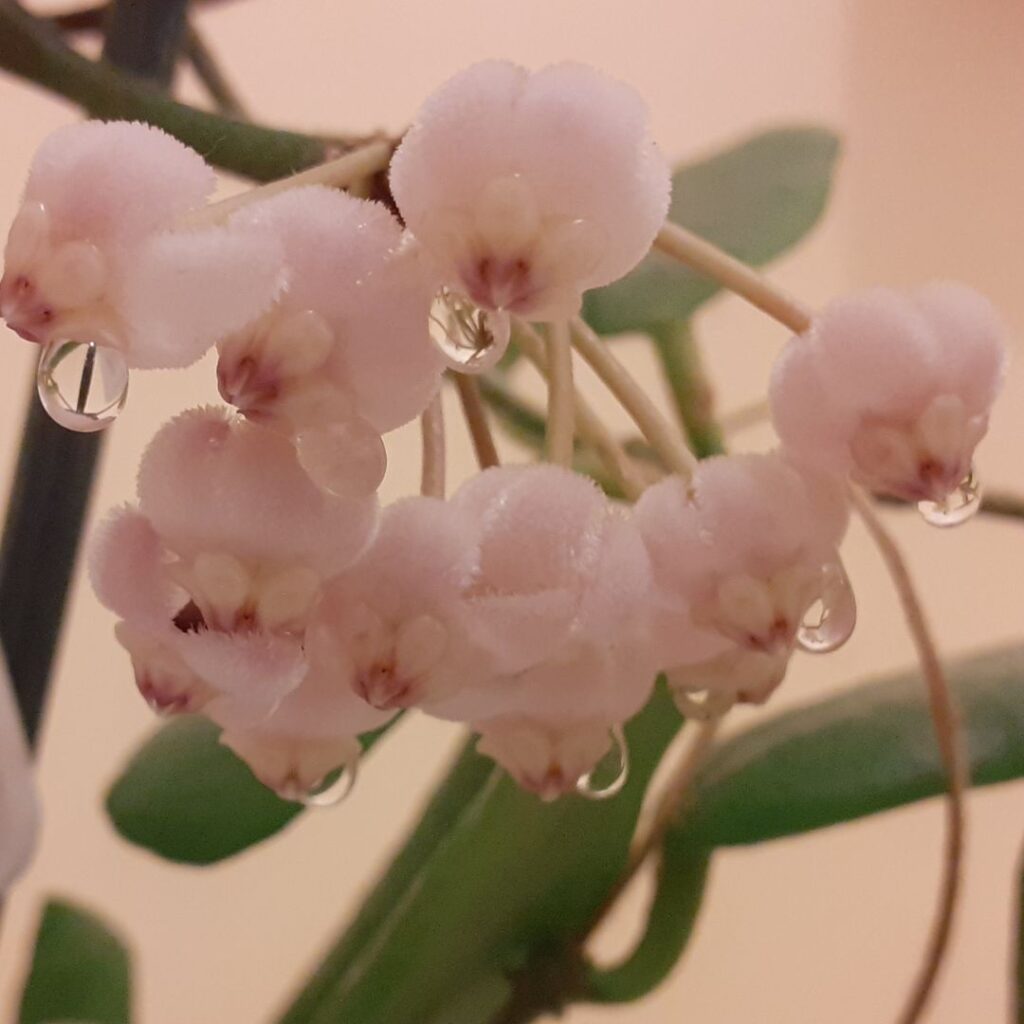
Hoya Rotundiflora Humidity
Since the Hoya Rotundiflora is from Thailand, higher humidity above 50% will result in a happier plant. Invest in a humidifier or try out using a pebble tray. A pebble tray is simply a tray filled with rocks that is deep enough to hold water. Then, place your plant on top. The water evaporating from the tray beneath the plant will provide higher humidity. If you’re unable to provide this, they will still fare well in regular household humidity levels.
Tip: you can buy a humidity meter (affiliate link) to keep an eye on maximum and minimum levels.
Temperature
As with other tropical plants, a range 55° F and 80° F or around 13° C to 26° C is tolerable. Ideally, however, the best growing range would be 70° F to 80° F or around 21° C to 26° C.
How to Propagate Hoya Rotundiflora
Hoya Rotundiflora can be propagated by taking cuttings of nodes. A node is the area on the stem that two leaves grew from. You’ll want to cut on either side of this area. In other words, cut on the stem in-between the leaf clusters. After cutting, it is best to wait around 12 hours for the ends of the stem to callus. Then, you can pop all your propagations in a cup of water. Keep an eye on these cuttings to make sure that no root rot forms. If the stem of your cutting begins to turn black and mushy, this is root rot. All you need to do is cut this portion off, let it callus off, and try again. Once roots have formed you nca pot them up into soil.
Hoya Rotundiflora USDA Zone
They can live outside if you live in zones 10-12.
Where To Buy
Try our list of Rare Plant Shops.
FAQ’s
- “Rotundiflora” means exactly what it sounds like, round foliage. The genus of Hoya was named in the memory of Thomas Hoy.
- There are over 500 different species of Hoya.
- Hoya can be found in the wild throughout Southeast Asia and some in Australia. Hoya Rotundiflora specifically is found in Thailand.
- The Hoya Rotundiflora will seep a milky latex if you cut the stem or leaves. This can cause allergic reactions so it is best not to touch or ingest this.
Hoya Rotundiflora Common Issues, Pests, and Treatments
The most common pests for Hoyas are Mites and Aphids. Both of these pests can be taken care of by wiping the leaves of your Hoya with neem oil.
Root rot is another issue that is more likely to occur with Hoyas due to their smaller root system and their requirement of well-draining soil. Root rot can go for a while without being noticed unlike other tropical plants. The leaves of the Hoya are resilient and will not show root rot right away. If you notice that your soil is not draining properly or is compact, take care of this right away by repotting in a more airy mix. Or, if you notice stunted growth, wilty leaves, or black spots on the lower portions of the stem, evaluate your plant for root rot.
Additional Resources
Buy: we recommend a digital thermometer hygrometer (amazon affiliate link) to measure humidity.
Links:
- More info on the Kew Gardens plant page.
- More info on the Vermont Hoyas plant page.
Other Articles You Might Like
There you have it, here ends our guide to this beautiful plant. You might also like our other articles: Hoya Soil, Hoya Lacunosa, Hoya Curtisii, Hoya Compacta Care.
Please follow us on Instagram and Pinterest for regular plant updates and occasional plant giveaways.
